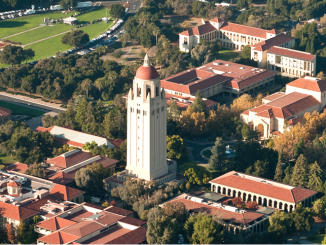
GUEST OPINION
BY PETER DREKMEIER
The debate over development in the Stanford foothills dates back to the founding of the university. Frederick Law Olmsted, Leland Stanford’s pick to design the campus, originally envisioned the university in the foothills.
However, Stanford insisted it be sited down in the flats, and so it was. Today the foothills are prominently featured in the university’s promotional materials as the scenic backdrop to Palm Drive, the Oval and the Main Quad.
Many of us enjoy walking the Dish loop, or simply appreciating the foothills while traveling 280, Page Mill, Junipero Serra or Alpine Road. But we can’t afford to take the scenic vistas, recreational trails and wildlife habitat for granted. In fact, the open space protections established under Stanford’s last General Use Permit (GUP) are set to expire in 2025.
Room to grow on core campus
With Stanford planning for a new wave of development under its 2018 GUP, it’s time to settle the issue once and for all. The foothills should be protected in perpetuity as permanent open space.
The county’s recently released supplement to Stanford’s Sustainable Development Study addresses maximum build-out scenarios for the campus. It makes clear that development in the foothills is unnecessary. The study determined that the university could conceivably triple in density without sprawling outside of the core campus. Given natural resource and community tolerance constraints, such massive growth is highly unlikely to ever occur.
Water, traffic, housing
The study points out that water supply could become a constraint during droughts if the university were to grow by slightly more than a third of its current size. Other constraints, such as traffic and housing impacts, are more nebulous, and depend largely on what neighboring communities are willing to tolerate.
Under its current GUP application, Stanford has requested the right to add 3.5 million square feet of new development (academic and housing) over a 15-year period. This is the equivalent of two-and-a-half Stanford Shopping Centers. If permitted by the county, the trade-off should be permanent protection of the foothills.
No density limits
Stanford’s current zoning is unique in Santa Clara County in that it does not include a density limit. Under the 2000 GUP, the Stanford foothills were redesignated from “Academic Reserve” to “Open Space and Field Research,” which was a positive step. However, this is not true zoning, and there are no long-term density restrictions — such as under “Hillside Zoning” elsewhere in the county, or through an established floor-area ratio (FAR) — that provide a sense of Stanford’s overall development rights.
If the Stanford foothills were zoned for density, it could be argued that the county should pursue a Transfer of Development Rights (TDR), shifting Stanford’s right to develop in the foothills to the core campus. Stanford would be allowed to develop its campus more densely (which is already happening) in exchange for foregoing development in the foothills. It is not fair that Stanford continues to add density, yet reserves the right to develop the foothills in the future.
Putting a cap on development
And, very importantly, the Santa Clara County Board of Supervisors should condition approval of Stanford’s 2018 GUP upon agreement that at the end of its life in 2035, Stanford will be considered fully developed, and shall adhere to a policy of no-net-new academic development. The university could adapt to changing times by repurposing buildings that house outdated uses, or replacing less functional buildings with new ones of equal square footage.
We need to acknowledge limits to growth and the importance of not exceeding the carrying capacity of our region. Stanford, with all of its brilliant minds, can continue to excel as an academic institution without building in the foothills. Looking to the future, Stanford’s challenge is to meet its worthy goals and have a lasting positive impact in the world without leaving a lasting negative impact on our region through never-ending physical growth.
Peter Drekmeier is a former mayor of Palo Alto, and former director of the Stanford Open Space Alliance.




Sure. Stanford can donate the land to a non-profit conservation organization.